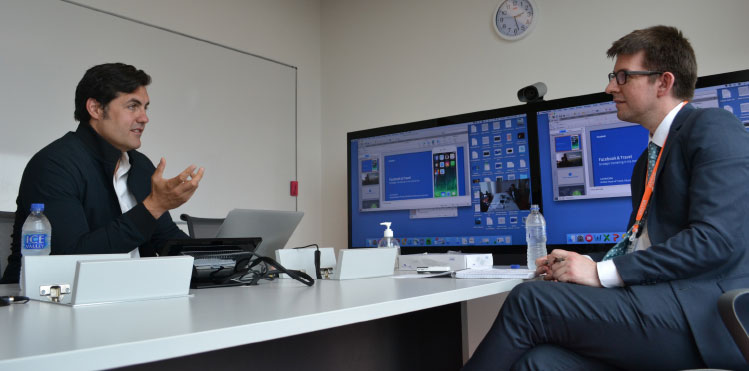
Facebook Head of Travel Lee McCabe told Airport Business’ Ross Falconer that smartphone apps are where airports, airlines and other stakeholders across the travel journey should really be focusing their efforts. “There’s so much you can do with apps – you can leverage all the signals from the smartphone and create a far better experience.”
Facebook Head of Travel Lee McCabe, interviewed by Ross Falconer.
The digital revolution has enabled airports to engage directly with travellers like never before. Social media is a major driver of this, enhancing the travel experience by allowing airports to forge direct relationships with their passengers and supporting their transformation from B2B to B2C businesses. Facebook, with 1.5 billion active users worldwide, offers unparalleled opportunities to interact with passengers, whether it be through Facebook ‘check-ins’ or as a platform for customer service queries.
The ACI EUROPE Digital Report 2014-2015 highlighted some fascinating figures; at the time of publication, there were 289 European airports present on Facebook, with a collective three million fans. Meanwhile, 164 of Europe’s airports offered branded smartphone apps.
Indeed, the connected traveller now has a symbiotic relationship with their smartphone, and this creates huge opportunities for businesses, including airports. However, they are opportunities that airports are not yet capitalising on, according to Facebook Head of Travel Lee McCabe. He told Airport Business that “most are playing catch-up, especially when it comes to apps”.
McCabe explained that smartphone apps are where airports, airlines and other stakeholders across the travel journey should really be focusing their efforts. “There’s so much you can do with apps – you can leverage all the signals from the smartphone and create a far better experience,” he said. “One of the questions we get asked a lot by companies is: ‘Should we develop an app or mobile web?’ If we look at the big companies in the US for an indication – the majority of website visits are mobile-only or multi-platform. If you look at Amazon and eBay and what they’re using, it’s apps – so apps are dominant. The companies who get it right are developing good apps that are working well.”

Airport Business’ Ross Falconer tried out the Oculus Rift virtual reality headset, which will be launched in 2016 and, according to McCabe, could prove to be as revolutionary as the launch of the iPhone in 2007. He explained that there are potential use cases for Oculus Rift in the travel sector.
Providing context is also important – utilising beacon technology, for example, offers airports the opportunity to target travellers with relevant information, such as promotional vouchers in the retail environment, or flight status updates. “Then convenience is essential – just make that app easy to use. Have a good app, perhaps partnering with your retail environment, or with the airlines, but whatever the objective is make sure I can do it easily in that app,” McCabe emphasised.
Expanding on that, his advice to airports is to view their app as a platform, which provides the vital flight information and services, but can also be enhanced and developed by third parties. “That’s where the real innovation takes hold, and it would bring increased value and convenience to passengers,” he commented.
As regards how businesses use Facebook, McCabe asserted that the word ‘social’ is irrelevant. “Businesses who understand the platform well just view it as an advertising/marketing platform – they think, there’s 1.5 billion active users and we can target them very specifically,” he said. “I think the problem is that airports are still in this ‘social’ world, and that’s what held a lot of businesses back. To begin with, companies got confused by the word ‘social’ and thought it was about ‘likes’ and ‘fans’. As soon as they view it as a platform where they can target people very specifically, it works much better for them.”
Digital technologies are already a major component of most airports’ business strategies, and the pace of evolution offers exciting opportunities for even greater interaction with travellers. It will be interesting to see how increased smartphone functionality and wearable technology, for example, can be utilised in the airport environment, and indeed what further developments may appear on the horizon.







